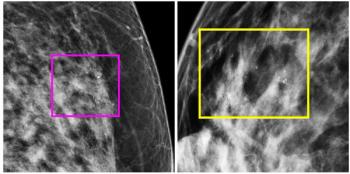
Contrast adds clarity to digital mammography
Adding contrast media to high-energy digital mammography studies can generate clearer images of difficult-to-spot breast masses. The use of contrast and digital subtraction algorithms led to results similar in clarity to breast MR in a small investigational study by German researchers.
Adding contrast media to high-energy digital mammography studies can generate clearer images of difficult-to-spot breast masses. The use of contrast and digital subtraction algorithms led to results similar in clarity to breast MR in a small investigational study by German researchers.
Dr. Felix Dietmann and colleagues at Charite Hospital in Berlin performed high-energy digital mammography on 10 women with 12 suspicious lesions before contrast administration and 60, 120, and 180 seconds after. Contrast imaging revealed all 12 lesions, three of which had been missed on the unenhanced views.
Despite the ease of identifying the lesions, the process lacks MR's ability to characterize masses based on contrast uptake and washout curves. In the study population as well as subsequent cases, Dietmann found that malignancies, fibroadenomas, and other masses all showed enhancement without a consistent pattern.
The technique may, however, have two advantages: To maximize the effectiveness of the contrast, the imagers used much less breast compression than they would need for a standard mammogram, improving patient comfort. The improved visibility of masses may also make biopsy procedures more accurate while keeping the process cheaper and simpler than using MR guidance.
Newsletter
Stay at the forefront of radiology with the Diagnostic Imaging newsletter, delivering the latest news, clinical insights, and imaging advancements for today’s radiologists.




























